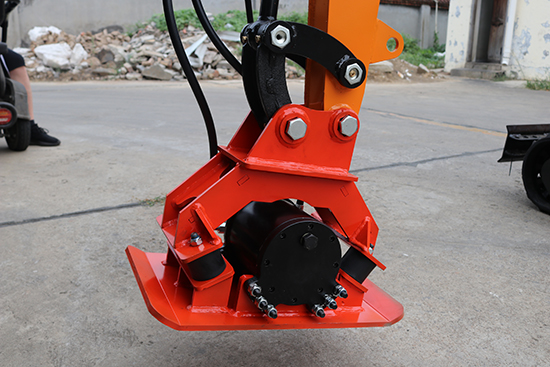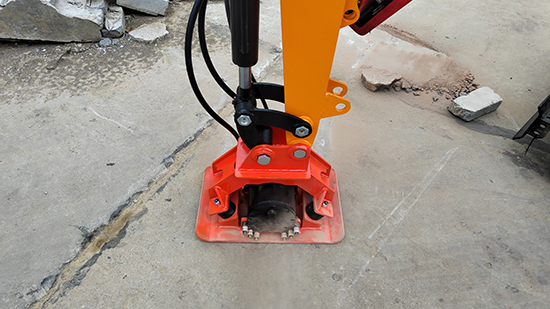I. Feasibility of Installation
Structural Compatibility
Small excavators usually have a flexible connection system for working devices. Generally, by installing an adaptable connection device at the end of the excavator's stick or boom, the plate compactor can be attached. This connection method is similar to replacing the excavator's attachments, such as changing the bucket to a breaker.
For example, many small excavators have reserved hydraulic pipeline interfaces and mechanical connection points on the stick. These interfaces and connection points can be modified slightly or used directly to install the plate compactor. The plate compactor itself is also designed with corresponding connection components, and its dimensions and specifications can match the connection devices of the small excavator to ensure the firmness of the installation.
Power Supply Aspect
Small excavators have sufficient hydraulic power to drive the plate compactor. The hydraulic system of the excavator can provide stable pressure and flow. The plate compactor can obtain power through the oil pipes connected to the excavator's hydraulic system during operation.
The hydraulically driven plate compactor can use the hydraulic power of the excavator to generate high - frequency vibrations. The vibration frequency and amplitude can be adjusted to a certain extent according to actual work requirements. For example, when compacting some loose soil or sandy - gravel mixed ground, the vibration frequency can be appropriately increased to improve the compaction effect.

II. Advantages after Installation
Improve Work Efficiency
Compared with manual use of handheld plate compactors or other small compaction equipment, the plate compactor installed on a small excavator has a larger working range. The excavator can flexibly move the plate compactor to the position where compaction is required. Especially in large - area site leveling and compaction operations, it can quickly cover the entire working area.
For example, in the foundation compaction of construction sites or the subgrade compaction in road construction, the small excavator with a plate compactor can operate continuously along the planned route, reducing the time for equipment transfer and re - positioning.
Enhance Compaction Effect
Due to the weight and stability of the excavator itself, it can provide better downward pressure when operating the plate compactor. While the plate compactor is vibrating, the downward pressure of the excavator can effectively increase the compaction depth and density.
For some projects with high requirements for soil density, such as the foundation treatment under the raft foundation of a building, the small excavator installed with a plate compactor can better meet the engineering quality requirements.

III. Precautions for Installation
Inspection of Connection Stability
After installing the plate compactor, it is necessary to carefully check whether the connection part is firm. The connection bolts should be tightened to the specified torque, and regular inspections should be carried out to prevent the connection from loosening due to vibration during operation.
For example, a test run can be carried out after the initial installation to observe whether there are any abnormal shaking or noises at the connection part. If so, the connection needs to be re - inspected and reinforced.
Adaptation and Adjustment of the Hydraulic System
It is necessary to ensure that the hydraulic system of the excavator is compatible with the hydraulic parameters of the plate compactor. This includes parameters such as the flow rate and pressure of the hydraulic oil. If the parameters do not match, the plate compactor may not work properly, such as insufficient vibration frequency or excessive vibration that may damage the equipment.
Generally, it is necessary to make appropriate adjustments to the hydraulic output of the excavator according to the operation manual of the plate compactor. It may be necessary to install some flow control valves or pressure regulating valves to optimize the output of the hydraulic system.